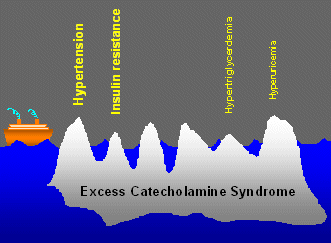Unfavourable lifestyle
Unhealthy
diets
BMI
calculation
BMI
and BP
Salt
intake
Alcohol
Hypertension
BMI and SNS
Hyperkinetic HT
Established HT
Systolic HT
Renin /
Angiotensin II
Diabetes type-2
Insulin
resistance
Diabetes
type-2
Metabolic
syndrome
Therapy
Imidazoline
receptors
Moxonidine
Home page
International Society for Molecular
Nutrition and Therapy
other
sites maintained by us:
www.cardiorepair.com
www.carditis.com
www.herzzentrum-marburg.de
www.physio.carditis.de
|
The
site focusses on links between lifestyle, sympathetic
overactivity and cardiovascular disease. Therapeutics are
described which counteract sympathetic overactivity by
reducing catecholamine release: the centrally acting
imidazoline I1 receptor agonist moxonidine and the
angiotensin receptor blocker (ARB) eprosartan with a high
presynaptic inhibitory action on norepinephrine release.
Since eprosartan has a unique structure, i.e. the first
non-tetrazol and non-biphenyl ARB, it differs from other
ARBs by inhibiting more potently presynaptic
norepinephrine release. Eprosartan controls high blood
pressure by a "dual mechanism of action". Based on
this dual mechanism of action, the "Teveten
Song - The Power of Two" has been composed and
presented by the singers Ogie and Janno on occasion of the
Teveten Launch in Manila, May 27, 2003.
An overview on the EXCESS CATECHOLAMINE SYNDROME
can
be
downloaded as PDF.
An
update focuses on "Addominal
fat
and sympathetic overactivity - from calorie
intake to postmenopausal hypertension"
|
